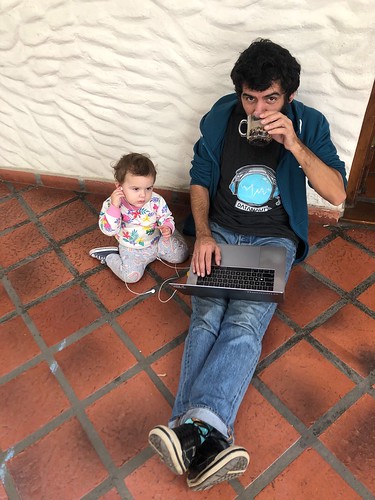I always liked the interviews at Uses This, I find it really interesting knowing other people’s setups. And given that I do not foresee them interviewing me anytime soon, I went ahead and wrote my own.
Who are you, and what do you do?
I’m Leandro López, better known on the Internet as inkel (all lowercase). I work as a software developer at Theorem, mostly doing backend programming but also dabbling in operations when needed. I’m interested in programming as a science, machine learning, DevOps (whatever that means), and keeping systems running.
What hardware do you use?
My main machine is a MacBook Pro 2015 15", which I love. I’ve also have a secondary Dell XPS with Windows 10. Meh.
I, like everyone else, do not like the new butterfly keyboard, and because of that I’m using a Keychron K2 as an external, mechanical keyboard; I love this keyboard, it’s clickly but not too loud, it can connect to up to 3 devices and seamlessly change from one to the other by pressing a couple keys. The only thing I miss in this keyboard is a Touch ID reader.
For a long while my hands travelled from the K2 to my MBP touchpad, and that was becoming tedious. I love the touchpad, but buying an external one was costly in Argentina, and thus I bought a trackball for the first time in my life, as I also wanted to give them a try. I’ve got a Logitech Ergo MX and boy am I happy with it. It didn’t take me too long to get used to it, and while it’s not the same as the touchpad, it is customizable so I can do many things without leaving my hand off the trackball. Still, I would like for it to have a couple more buttons so I can customize it even more.
As I work in a 100% remote company, calls are something that happen almost daily. For that reason I use mostly Apple EarPods, they work just great. At my office I’ve a pair of Logitech G533, which sounds great and are wonderful, but have two main issues to my taste: 1. they are not Bluetooth, you need a USB receptor connected to your computer; 2. after 15 minutes of audio silence (i.e. no audio coming through the speakers), it powers off, which is troublesome if you are doing a presentation and the rest of the audience is muted; I’ve already felt the pain of talking and talking and talking and people trying to tell me they couldn’t hear me but I couldn’t hear them either because the headset was off. Sad emoji. I’ve also bought a pair of Philips SHB3075, they are comfortable and 100% Bluetooth, but for some reason they don’t work well with my MBP, so I’ve them paired with my iPhone.
When mobile I use an iPhone 8, one that needs a change because my screen shattered. I started using iPhones since the iPhone 5 and never looked back. They are fast, pretty, and just work, as anything from Apple. Are they expensive? Yes. Are they worth it? Hell yes.
I prefer reading physical books than ebooks, nevertheless, I’ve an iPad Mini mostly for just that. It’s a great device with an excellent size for reading and taking from one place to another, without being a fullsized iPad.
Last but not least, as a developer I spend most of my days sitting, and I’m over 40, so a good chair is more than just luxury. Because of that I own a Erasmo Onix, and my life (and back) has been happier ever since. I cannot stress enough how much I recommend to spend serious money on a good chair.
And what software?
On my main computer, macOS as the operative system. It’s pretty, it works, it makes me happy. But I know I’ve to upgrade to Catalina soon.
Given I’m a developer, most of the things I write happens in Emacs. My init.el is far from perfect and I’ve neglected updating it for a long time. Sometimes I use Visual Studio Code (VSCode) or Visual Studio for Mac, but I always end up coming back to Emacs.
When I’m not on Emacs, I spend most of my time in a few iTerm2 tabs. I’ve tried other terminals like kitty, and while much faster, it’s definitely nowhere near in UX. Besides using tabs I also use tmux a lot. A LOT. My tmux.conf is adequately updated to my tastes, although it could use some improvement. Yes, I’ve heard about iTerm and tmux integration; no I haven’t tried it. I use Bash. I’m super comfortable with it, so I’m not looking to change to another shell in the short term.
Writing Markdown is something I find myself doing every so often, and for that, I use Typora. It’s beautiful, elegant, fast, I love it. I might switch to Bear, though, as I’ve been trying it on my cellphone and it works really well, even without the Pro features; I might upgrade to Pro soon, still haven’t decided. This blog is using Typora for the content and Hugo as the static site generator.
My other computer runs Windows 10. Windows as an operating system has improved a lot over the years, but it’s still, in my opinion, not very developer friendly as an operating system. For writing code, Visual Studio is undoubtedly one of the best IDEs there is, although of course mostly tied to developing within the Microsoft platform. I also have VSCode installed: sometimes I just need something that loads fast for quick edits. SQL Server Management Studio is another great tool though it feels a bit dated.
CLI is where I feel Windows fails the most, and while the new Windows Terminal looks promising, it still lacks the smooth UX that other terminal emulators like iTerm2 have. The Windows Subsystem for Linux (WSL) is another great addition to CLI on Windows, but again, still a bit clunky.
Languages are varied: I really enjoy writing Ruby, love toying with Go, have enough fun to work with .NET Core and C#. I like to have as much infrastructure as possible described using Terraform. And I really, really love writing scripts using Bash, AWK, sed, curl, and jq.
Last but not least is The Cloud. Nothing surprising there: GitHub for own and Open Source code, and some work related stuff. Amazon Web Services and Microsoft Azure for hosting stuff.
What would be your dream setup?
I’d love to get my hands on one of the newer MacBook Pro 16" with at least 32 GB of RAM and an SSD of at elast 1TB. I don’t think I’m going to try a new mechanical keyboard for the time being, but the Keychron K8 looks like a good future replacement. Similar with my mouse, I’ll continue with my Logitech Ergo MX, but also looking forward to get an Apple Magic Trackpad 2.
I’d like to improve my communications setup, probably by getting some AirPods Pro, or a cool Bluetooth headset.
My office needs some love, and due to the Covid-19 pandemic I’m not even going, but once back I’d like to have one or two external monitors, and a good microphone. I don’t have anything in mind yet, though.
As said my phone needs a change, and I’m looking forward to buying an iPhone 11. I’d also like to leave my computer at the office but still having something portable and comfortable at home where I can do some coding, and that’s why I’ve an iPad Pro in mind.
I want to have my office devices accessible from home, and thus I’m looking at using Tailscale. I’ve only heard amazing things about them.




